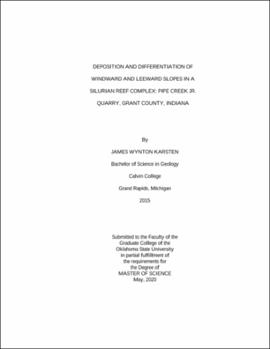| dc.contributor.advisor | Grammer, G. Michael | |
| dc.contributor.author | Karsten, James Wynton | |
| dc.date.accessioned | 2020-09-09T21:48:18Z | |
| dc.date.available | 2020-09-09T21:48:18Z | |
| dc.date.issued | 2020-05 | |
| dc.identifier.uri | https://hdl.handle.net/11244/325548 | |
| dc.description.abstract | Silurian reefs are significant hydrocarbon reservoirs in the Michigan Basin, having produced over 490 MMBO and 2.9 TCF of gas. Primary production from the reefs is typically averages 20-25% due to the complex internal heterogeneity of the reservoir. To date, a majority of the exploration and development of these reservoirs has been directed towards the cores of the reefs, rather than the associated reef slope deposits. Reef slope deposits exposed in the Pipe Creek Jr. reef quarry complex of Indiana exhibit many similarities to several other productive slope reservoirs reported from the rock record (e.g. Tengiz and Karachaganak in the Caspian region). As such, an understanding of the depositional processes and the resulting geometry of potential reservoirs and seals in these Silurian reef slopes may provide valuable insight into the formation and evolution of similar slope deposits. | |
| dc.description.abstract | This study is focused on the upper slope (forereef) deposits of the Pipe Creek Jr. reef complex and includes an analysis of the facies distribution, bed geometry, faunal distribution, and reservoir characterization of the reef slope deposits, coupled with the development of a drone-based, georeferenced outcrop model. The main objectives of the study include determining how the slope beds were deposited and whether a windward/leeward orientation for the reef system can be determined by examining the slope beds. The Pipe Creek Jr. Reef has been previously studied with a focus on faunal assemblages, dolomitization of the reef, and the general depositional facies of the reef core. The reef complex has a minimum thickness of 48m, and the original height of the reef has been speculated as being anywhere from 35 to 200 meters. The exposed reef flank (forereef) facies consist of a mixture of coarse skeletal grainstone-packstone, skeletal mudstone-wackestone, and argillaceous silty dolomite mudstone. Similar to other forereef deposits, lenticular bedding consisting of skeletal packstone and grainstone deposited by grainflow make up the majority of the 40-45° depositional slopes. A proposed S to SE dominant wind direction was determined through analysis of slope declivity, facies composition, percent facies coverage, syndepositional marine cement, faunal diversity, and faunal density. This wind direction is corroborated by other studies of Silurian reefs in the Michigan basin, as well as by paleoclimactic modeling of the Wabash Platform. | |
| dc.format | application/pdf | |
| dc.language | en_US | |
| dc.rights | Copyright is held by the author who has granted the Oklahoma State University Library the non-exclusive right to share this material in its institutional repository. Contact Digital Library Services at lib-dls@okstate.edu or 405-744-9161 for the permission policy on the use, reproduction or distribution of this material. | |
| dc.title | Deposition and differentiation of windward and leeward slopes in a Silurian reef complex: Pipe Creek Jr. Quarry, Grant County, Indiana | |
| dc.contributor.committeeMember | Puckette, James | |
| dc.contributor.committeeMember | Pashin, Jack | |
| osu.filename | Karsten_okstate_0664M_16760.pdf | |
| osu.accesstype | Open Access | |
| dc.type.genre | Thesis | |
| dc.type.material | Text | |
| dc.subject.keywords | carbonate sedimentology | |
| dc.subject.keywords | geology | |
| dc.subject.keywords | petroleum geology | |
| thesis.degree.discipline | Geology | |
| thesis.degree.grantor | Oklahoma State University | |
